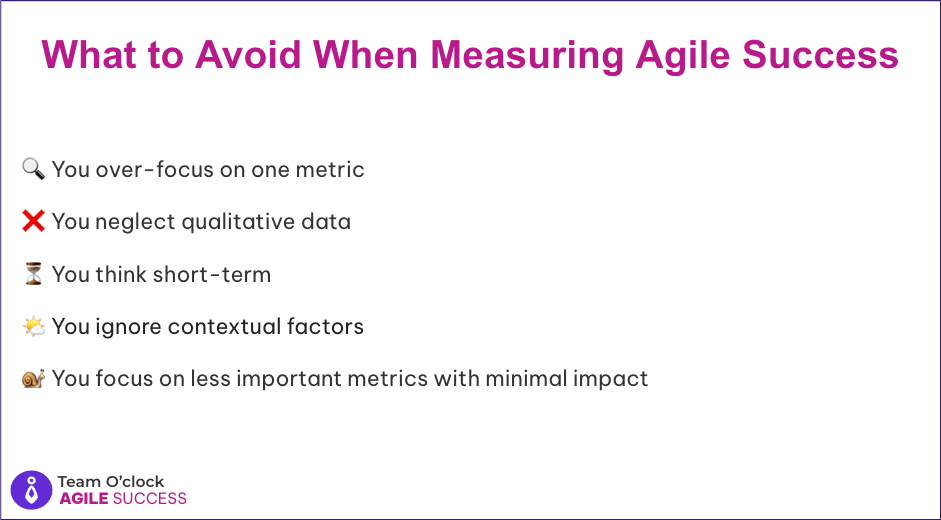
How to Measure Success in Agile Projects

Agile methodologies have quickly become a no-brainer across teams from various industries because they offer flexibility, collaboration, and iterative progress.
However, while metrics are essential for evaluating performance, it's unrealistic to track every possible one. Instead, it's crucial to focus on the key metrics that resonate with your team and contribute directly to project success.
In this blog, we’ll highlight the 3-4 must-have metrics that will drive continuous improvement and deliver value to your customers, while also discussing common pitfalls and how to maintain a balanced approach for long-term Agile success.
What You Need to Track for Your Agile Success
Success in Agile isn’t just about completing tasks faster. It requires balancing delivering value to customers, maintaining team commitment, and promoting a healthy, sustainable team environment. These three elements are critical to Agile project success:

1. Customer Impact
Customer impact measures how well your product or service is meeting the needs of your users. Metrics like user engagement, satisfaction, and feature requests are vital indicators of how successful a project has been from a customer’s perspective.
You can use surveys, Net Promoter Score (NPS), and product analytics to track how customers interact with your product and gauge their satisfaction. Understanding customer feedback will help you identify whether the features being developed are actually making a positive impact.
2. Team Commitment
In Agile, delivering on promises is a crucial aspect of success. A team’s ability to meet its sprint goals reflects how well it understands the scope of the work and its capacity to complete it within the given timeframe.
How to Build Commitment: Setting realistic goals, ensuring tasks are broken down into manageable chunks, and holding regular check-ins can help foster a sense of ownership and accountability within the team.
Delivering on Promises: When a team repeatedly meets its sprint commitments, it signals that they are well-aligned and understand their responsibilities, contributing to the overall success of the project.
3. Team Health
A successful Agile team must also be a healthy one. Happy, engaged team members are more productive and can better handle the challenges that arise during projects.
Psychological Factors: Burnout, stress, and miscommunication can derail any Agile team. Regular retrospectives and pulse checks can help ensure that team members feel supported and that workloads are balanced.
Preventing Burnout: One key to maintaining team health is ensuring psychological safety—where team members feel comfortable voicing concerns and suggesting improvements. Leaders must foster an environment where open communication is encouraged.
The Must-Have Metrics to Track Your Agile Progress
Tracking the right metrics is key to evaluating how well your Agile team is performing. Here are three must-have metrics that cover the essential areas of customer impact, team commitment, and team health.
1. Customer Impact Metrics
Direct Measurement: Track customer engagement with tools like Google Analytics to measure how frequently users interact with new features or services.
Indirect Measurement: Gather qualitative feedback from customer surveys or analyze customer support tickets for trends.
Timing: Don’t measure customer impact only at the launch. Ensure you measure at intervals (e.g., one month, six months) to see how it changes over time. You can use automated tools to streamline this process and track customer feedback continuously.
2. Team Commitment Metrics
Completion Rate: This metric measures how well your team meets its sprint commitments. A high completion rate shows that the team is aligned and capable of delivering the promised work.
Collaboration and Understanding: The completion rate also reflects how well the team collaborates and communicates. If tasks are often left incomplete, it might be a sign of poor task understanding or misaligned priorities.
Over-Optimism: Sometimes teams overestimate their capacity. Mitigating over-optimism involves better planning, using techniques like Planning Poker to estimate tasks accurately.
3. Team Health Metrics
Subjectivity in Measurement: Team health can be difficult to quantify. However, it’s crucial to gather qualitative data, such as feedback from retrospectives or mood checks, to understand the well-being of your team.
Retrospectives and Mood Checks: Use digital tools, like Slack add-ons or dedicated team health platforms, to gather real-time insights into how team members feel.
Correlation with Performance: Happier teams tend to be more productive, and there is a direct link between team morale and the quality of the work produced.
What to Avoid When Measuring Agile Success

While it’s important to track key metrics, there are common pitfalls that teams can fall into when measuring Agile success. Here are a few to watch out for:
1. Over-focusing on One Metric
Teams often become overly focused on one metric, such as customer impact, while neglecting other important factors like team health or commitment. This can lead to burnout, missed deadlines, and poor long-term results. It’s essential to maintain a balanced approach and consider how all metrics work together to provide a holistic view of success.
2. Neglecting Qualitative Data
While quantitative metrics like completion rate and customer adoption are important, they don’t tell the whole story. Neglecting qualitative data from retrospectives, customer feedback, and one-on-one meetings with team members can result in blind spots that hinder your team’s performance and growth.
3. Short-Term Thinking
Focusing only on the success of individual sprints or short-term metrics can cause teams to lose sight of long-term goals. For example, if you only measure customer impact in the first month after a release, you might miss out on understanding how the feature performs over time. Successful Agile teams should track long-term trends and use them to refine their processes.
4. Ignoring Contextual Factors
Metrics don’t exist in a vacuum. External factors such as market changes, team restructuring, or evolving business priorities can skew results. Teams should be mindful of the broader context when analyzing performance metrics and avoid overreacting to temporary changes.
5. Focusing on Less Important Metrics with Minimal Impact
Some teams focus on less important metrics that, while helpful, don’t significantly impact the success of the Agile project. These include:
Time to Resolution: This measures the time between a work item’s creation and completion. While it shows how quickly a team can react to an important task, it doesn’t always indicate success.
Time a Task Stays in a Specific State: Tracking how long a task remains in a particular state (e.g., "in progress" or "review") can offer insights into team dynamics. However, a task staying in a state for too long could point to an issue with communication or task clarity.
Time to Complete a Task After it Starts: While this metric can highlight task complexity, focusing too much on it can lead to task breakdowns for the sake of speed rather than quality. Using this metric to identify areas where work definitions can be improved is more valuable.
Takeaway
Measuring success in Agile projects is essential to ensuring continuous improvement. By focusing on the right elements—Customer Impact, Team Commitment, and Team Health—and tracking critical metrics in these areas, teams can stay aligned with their goals and deliver meaningful results.
However, avoiding common pitfalls, such as over-focusing on one metric or ignoring qualitative data, is equally important. Success in Agile is not just about hitting specific numbers; it’s about maintaining a balance between customer satisfaction, team performance, and long-term sustainability.
Start today with Team O’Clock by implementing these metrics in your Agile project. Remember that measuring success is an ongoing process, not a one-time task.

More articles to check

Assist your team's growth with our partnership program:








